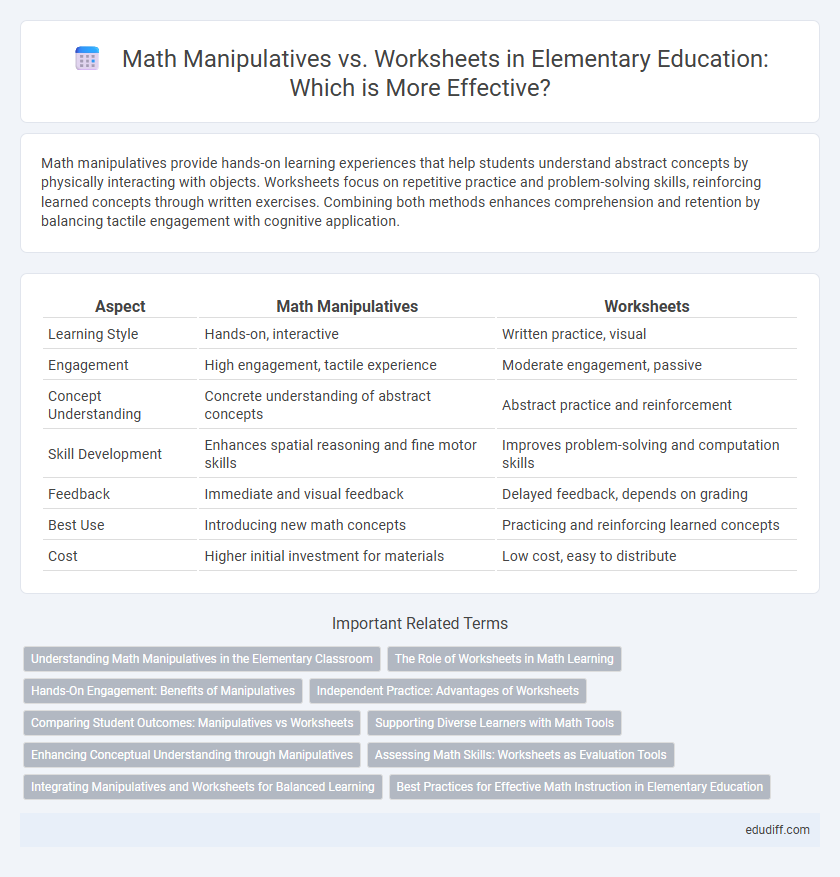Math manipulatives provide hands-on learning experiences that help students understand abstract concepts by physically interacting with objects. Worksheets focus on repetitive practice and problem-solving skills, reinforcing learned concepts through written exercises. Combining both methods enhances comprehension and retention by balancing tactile engagement with cognitive application.
Table of Comparison
| Aspect | Math Manipulatives | Worksheets |
|---|---|---|
| Learning Style | Hands-on, interactive | Written practice, visual |
| Engagement | High engagement, tactile experience | Moderate engagement, passive |
| Concept Understanding | Concrete understanding of abstract concepts | Abstract practice and reinforcement |
| Skill Development | Enhances spatial reasoning and fine motor skills | Improves problem-solving and computation skills |
| Feedback | Immediate and visual feedback | Delayed feedback, depends on grading |
| Best Use | Introducing new math concepts | Practicing and reinforcing learned concepts |
| Cost | Higher initial investment for materials | Low cost, easy to distribute |
Understanding Math Manipulatives in the Elementary Classroom
Math manipulatives in the elementary classroom enhance conceptual understanding by allowing students to physically explore abstract math concepts such as addition, subtraction, and fractions. These hands-on tools, including base-ten blocks, fraction circles, and pattern blocks, support diverse learning styles and improve retention through tactile engagement. Worksheets primarily reinforce procedural skills and practice, while manipulatives build foundational comprehension and critical thinking in early math education.
The Role of Worksheets in Math Learning
Worksheets play a crucial role in math learning by providing structured practice that reinforces concepts and skills through repetition and problem-solving. They help assess student understanding and identify areas needing improvement, allowing targeted instruction. Regular use of worksheets supports the development of procedural fluency and boosts confidence in elementary math tasks.
Hands-On Engagement: Benefits of Manipulatives
Math manipulatives provide hands-on engagement that enhances understanding by allowing students to physically explore concepts, making abstract ideas concrete. This tactile learning approach boosts fine motor skills and encourages active participation, leading to improved retention and problem-solving abilities. Unlike worksheets, manipulatives foster collaborative learning and critical thinking by enabling students to experiment and visualize math processes in real time.
Independent Practice: Advantages of Worksheets
Worksheets provide consistent structure that helps elementary students practice math skills independently, promoting focus and self-paced learning. They allow for immediate repetition of specific concepts, reinforcing understanding through targeted exercises. The tangible format supports easy assessment of student progress and identification of areas needing improvement.
Comparing Student Outcomes: Manipulatives vs Worksheets
Math manipulatives improve student comprehension by providing hands-on experiences that enhance conceptual understanding and retention. Worksheets often reinforce procedural skills but may limit engagement and deeper learning compared to manipulatives. Research shows that students using manipulatives demonstrate higher achievement in problem-solving and critical thinking than those relying solely on worksheets.
Supporting Diverse Learners with Math Tools
Math manipulatives offer hands-on learning experiences that help diverse elementary learners grasp abstract concepts by engaging multiple senses and promoting active problem-solving. Worksheets provide structured practice and repetition, supporting skill reinforcement and assessment for students with varying learning paces. Combining manipulatives with targeted worksheets creates a balanced approach that addresses different learning styles and strengthens mathematical understanding.
Enhancing Conceptual Understanding through Manipulatives
Math manipulatives enhance conceptual understanding by providing hands-on experiences that help elementary students visualize and explore abstract concepts. Unlike worksheets, manipulatives engage multiple senses, making it easier for learners to grasp operations like addition, subtraction, and fractions. Research shows that using tools such as blocks, counters, and number lines improves problem-solving skills and encourages active learning in young children.
Assessing Math Skills: Worksheets as Evaluation Tools
Worksheets provide structured opportunities to assess elementary students' math skills, offering clear evidence of understanding in areas such as addition, subtraction, and basic geometry. They enable teachers to measure accuracy, speed, and problem-solving strategies through standardized tasks that are easy to grade and compare over time. Regular use of worksheets helps identify specific learning gaps and track progress, making them essential evaluation tools in early math education.
Integrating Manipulatives and Worksheets for Balanced Learning
Integrating math manipulatives with worksheets enhances elementary students' understanding by combining hands-on exploration with structured practice. Manipulatives provide concrete experiences that help visualize abstract concepts, while worksheets reinforce skills through repetitive problem-solving. This balanced approach supports diverse learning styles and improves mathematical fluency and retention.
Best Practices for Effective Math Instruction in Elementary Education
Using math manipulatives in elementary education enhances conceptual understanding by providing hands-on experiences that engage multiple senses and accommodate diverse learning styles. Worksheets serve as valuable tools for reinforcing skills, assessing mastery, and offering practice but should be balanced with interactive activities to avoid passive learning. Effective math instruction combines manipulatives for exploration with targeted worksheet exercises to support skill development and solidify comprehension.
Math Manipulatives vs Worksheets Infographic

 edudiff.com
edudiff.com